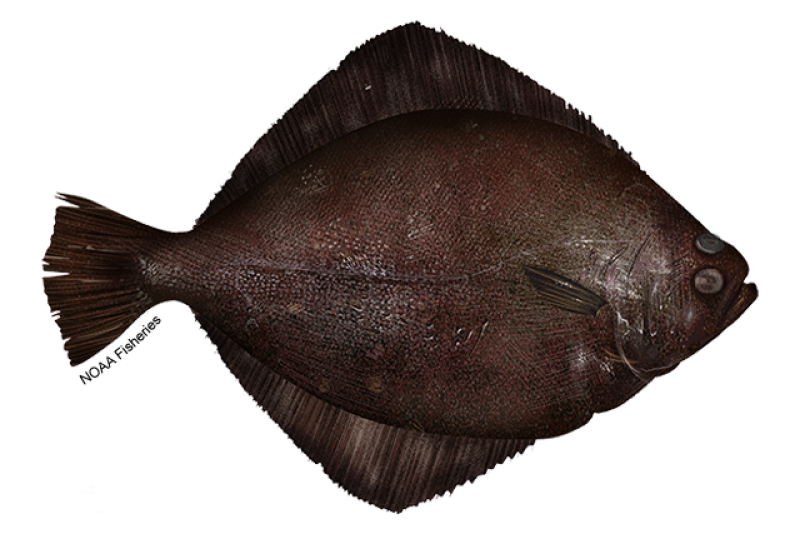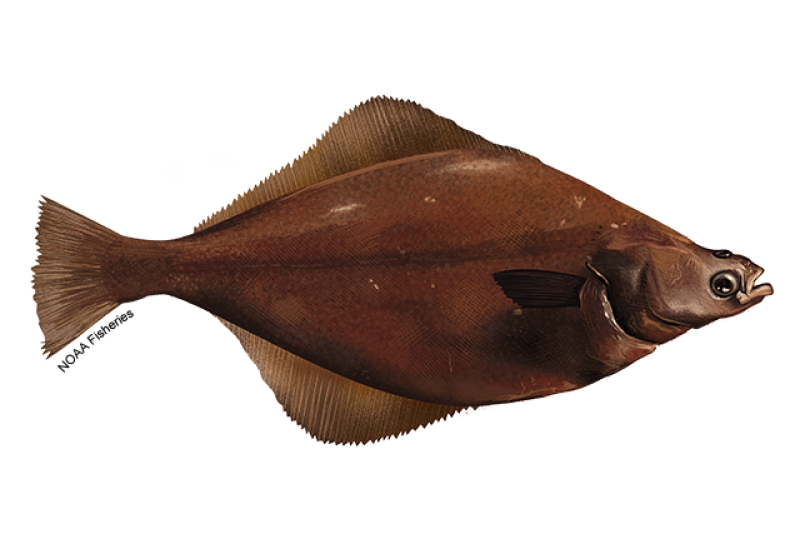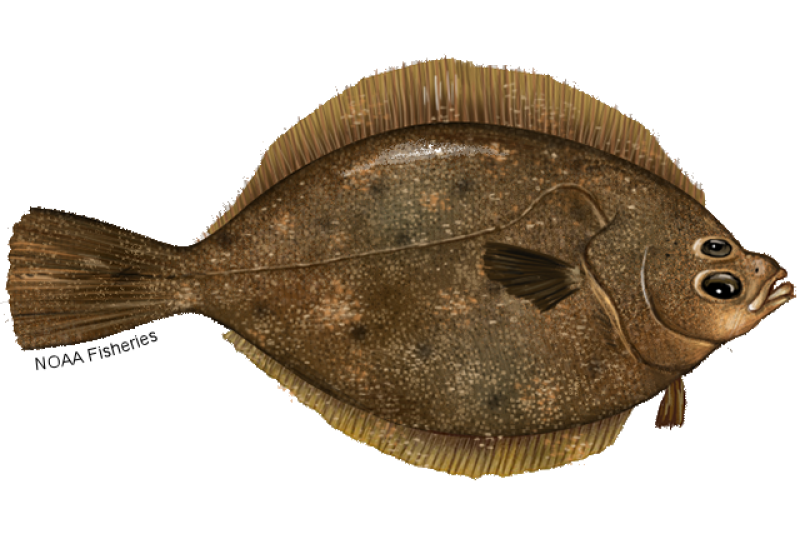About the Species
U.S. wild-caught petrale sole is a smart seafood choice because it is sustainably managed and responsibly harvested under U.S. regulations.

Population
The Pacific Coast stock is not overfished.

Fishing Rate
Not subject to overfishing.

Habitat Impact
Area closures and gear restrictions protect habitats that are affected by bottom trawls used to harvest petrale sole.

Bycatch
Regulations are in place to minimize bycatch.
Population Status
- There are three stocks of petrale sole: a Pacific coast stock, one stock contained in the Gulf of Alaska Shallow Water Flatfish Complex, and one stock contained in the Bering Sea/Aleutian Islands Other Flatfish Complex. According to the most recent stock assessments:
- The Pacific coast stock is not overfished (2023 stock assessment) and not subject to overfishing based on 2022 catch data. Summary stock assessment information can be found on Stock SMART.
- Petrale sole is managed as part of the Gulf of Alaska Shallow Water Flatfish Complex, but has not been assessed. The complex is not overfished based on the stock assessment of Northern rock sole - Central Gulf of Alaska (2021 stock assessment), Northern rock sole - Western Gulf of Alaska (2021 stock assessment), rock sole - Central Gulf of Alaska (2021 stock assessment), and rock sole - Western Gulf of Alaska (2021 stock assessment) which are regarded as the primary indicator species in this complex. The stock complex is not subject to overfishing based on 2023 catch data. Summary stock assessment information for Northern rock sole - Central Gulf of Alaska can be found on Stock SMART, Northern rock sole - Western Gulf of Alaska can be found on Stock SMART, rock sole - Central Gulf of Alaska can be found on Stock SMART, and rock sole - Western Gulf of Alaska can be found on Stock SMART.
- Petrale sole is managed as part of the Bering Sea/Aleutian Islands Other Flatfish Complex and has not been assessed so the population status is unknown. This complex is not subject to overfishing based on 2023 catch data.
Appearance
- Petrale sole is a right-eyed flounder (both eyes are on its right side), with an oval to round body.
- Its upper side is uniform light to dark brown, and its underside is white, sometimes with pink traces.
- Petrale sole have large mouths, with two rows of small, arrow-shaped teeth on their upper jaw and one row of teeth on the lower jaw.
Biology
- Petrale sole grow fast when they’re young, and females tend to grow faster than males.
- Females can reach up to 24 inches long, while males may reach up to 18 inches long.
- They can live up to 35 years, but recent data suggests few live longer than 17 years.
- Petrale sole can reproduce when they are 3 to 8 years old, or when they’re about 1 foot long. Females can produce 400,000 to 1.5 million eggs.
- They spawn from November to April in British Columbia, Washington, and Oregon. Spawning begins slightly earlier in California.
- Petrale sole is a broadcast spawner. Males and females release their sperm and eggs into the water column and eggs are fertilized externally.
- Eggs hatch in 6 to 13.5 days, depending on water temperatures.
- Petrale sole larvae spend their first 5 to 6 months up in the water column before they transform to their adult form and settle to the bottom.
- Petrale sole larvae eat plankton. Small juveniles eat mysids, sculpins, and other juvenile flatfish. Large juveniles and adults eat shrimp and other crustaceans, as well as krill, pelagic fishes, brittle stars, and juvenile petrale sole.
- Plankton-eating invertebrates and pelagic fishes eat petrale sole eggs. Adult petrale sole and other large flatfishes prey on juvenile petrale sole.
- Sharks, bottom-feeding marine mammals, larger flatfishes, and pelagic fishes feed on adults.
Where They Live
Range
- Petrale sole are found from Alaska to Coronado Island, Baja California.
- They are rare north and west of southeast Alaska and in the interior waters of British Columbia.
Habitat
- Petrale sole are common on the outer continental shelf in water 330 to 500 feet deep, but can be found in depths ranging from 50 to 1,370 feet.
- Adults migrate seasonally from deep water where they spawn to shallow water where they feed in the summer.
- Eggs and larvae are found in surface waters, and juveniles and adults live on sandy and muddy bottoms.
Fishery Management
- NOAA Fisheries and the Pacific Fishery Management Council manage the petrale sole fishery on the West Coast.
- Managed under the Pacific Coast Groundfish Fishery Management Plan:
- Limits on the number of permits and fishermen allowed.
- Limits on the minimum size of fish that may be harvested.
- Limit on how much may be harvested in one fishing trip.
- Certain seasons and areas are closed to fishing.
- Gear restrictions help reduce bycatch and impacts on habitat.
- A trawl rationalization catch share program includes:
- Catch limits based on population information for each fish stock and divided into shares that are allocated to individual fishermen or groups.
- These fishermen can decide how and when to catch their share – preferably when weather, markets, and business conditions are most favorable, allowing the fishery the flexibility to be more environmentally responsible, safer, more efficient, and more valuable.
- NOAA Fisheries and the North Pacific Fishery Management Council manage the petrale sole fishery in Alaska.
- Managed under the Fishery Management Plan for Groundfish in the Gulf of Alaska, and the Bering Sea and Aleutian Islands:
- There is no directed fishery for this species off Alaska, and only minor amounts are landed incidentally in other fisheries.
Harvest
- In 2023, commercial landings of petrale sole totaled 6.5 million pounds and were valued at $7.7 million, according to the NOAA Fisheries commercial fishing landings database.
- Gear types, habitat impacts, and bycatch:
- Bottom trawls are used to catch petrale sole.
- Trawls that are used to harvest petrale sole can contact the ocean floor and impact habitats, depending on the characteristics of the ocean bottom and the size of the gear.
- Bottom trawls cause minimal damage to habitat when targeting petrale sole over soft, sandy, or muddy ocean bottoms on the West Coast and Alaska.
- On the West Coast, NOAA Fisheries and the North Pacific Fishery Management Council have implemented large closed areas to minimize bycatch and protect habitat.
- Vessel monitoring systems allow enforcement staff and fishery managers to monitor GPS locations of fishing activities to ensure vessels are complying with closed areas.
Scientific Classification
- Petrale sole are found from Alaska to Coronado Island, Baja California.
- They are rare north and west of southeast Alaska and in the interior waters of British Columbia.
- Petrale sole are common on the outer continental shelf in water 330 to 500 feet deep, but can be found in depths ranging from 50 to 1,370 feet.
- Adults migrate seasonally from deep water where they spawn to shallow water where they feed in the summer.
- Eggs and larvae are found in surface waters, and juveniles and adults live on sandy and muddy bottoms.
Fishery Management
- NOAA Fisheries and the Pacific Fishery Management Council manage the petrale sole fishery on the West Coast.
- Managed under the Pacific Coast Groundfish Fishery Management Plan:
- Limits on the number of permits and fishermen allowed.
- Limits on the minimum size of fish that may be harvested.
- Limit on how much may be harvested in one fishing trip.
- Certain seasons and areas are closed to fishing.
- Gear restrictions help reduce bycatch and impacts on habitat.
- A trawl rationalization catch share program includes:
- Catch limits based on population information for each fish stock and divided into shares that are allocated to individual fishermen or groups.
- These fishermen can decide how and when to catch their share – preferably when weather, markets, and business conditions are most favorable, allowing the fishery the flexibility to be more environmentally responsible, safer, more efficient, and more valuable.
- NOAA Fisheries and the North Pacific Fishery Management Council manage the petrale sole fishery in Alaska.
- Managed under the Fishery Management Plan for Groundfish in the Gulf of Alaska, and the Bering Sea and Aleutian Islands:
- There is no directed fishery for this species off Alaska, and only minor amounts are landed incidentally in other fisheries.
Harvest
- In 2023, commercial landings of petrale sole totaled 6.5 million pounds and were valued at $7.7 million, according to the NOAA Fisheries commercial fishing landings database.
- Gear types, habitat impacts, and bycatch:
- Bottom trawls are used to catch petrale sole.
- Trawls that are used to harvest petrale sole can contact the ocean floor and impact habitats, depending on the characteristics of the ocean bottom and the size of the gear.
- Bottom trawls cause minimal damage to habitat when targeting petrale sole over soft, sandy, or muddy ocean bottoms on the West Coast and Alaska.
- On the West Coast, NOAA Fisheries and the North Pacific Fishery Management Council have implemented large closed areas to minimize bycatch and protect habitat.
- Vessel monitoring systems allow enforcement staff and fishery managers to monitor GPS locations of fishing activities to ensure vessels are complying with closed areas.
Scientific Classification
| Kingdom | Animalia | Phylum | Chordata | Class | Actinopterygii | Order | Pleuronectiformes | Family | Pleuronectidae | Genus | Eopsetta | Species | jordani |
|---|
Last updated by NOAA Fisheries on 03/21/2025
Featured News
 Offloading frozen Pacific cod from a catcher-processor vessel in Dutch Harbor, Alaska. Credit: NOAA Fisheries / Paul Hillman.
Offloading frozen Pacific cod from a catcher-processor vessel in Dutch Harbor, Alaska. Credit: NOAA Fisheries / Paul Hillman.
Economic Snapshot Shows Alaska Seafood Industry Suffered $1.8 Billion Loss 2022–2023
 A colony of the deep-sea coral Parastenella supporting a cluster of orange zoanthids and a deep-sea crab, extends from a ledge deep in Quinault Canyon off the coast of Washington State. Credit: Ocean Exploration Trust, NOAA Sanctuaries
A colony of the deep-sea coral Parastenella supporting a cluster of orange zoanthids and a deep-sea crab, extends from a ledge deep in Quinault Canyon off the coast of Washington State. Credit: Ocean Exploration Trust, NOAA Sanctuaries
Seafood Facts

Is Petrale Sole Sustainable?
U.S. wild-caught petrale sole is a smart seafood choice because it is sustainably managed and responsibly harvested under U.S. regulations.
Availability
Year-round.
Source
U.S. wild-caught from Washington to California.
Taste
Sweet, delicate, nutty flavor.
Texture
Fine.
Health Benefits
Petrale sole is an excellent source of low-fat protein and calcium.
Nutrition Facts
Servings: 1; Serving Weight: 100 g; Calories: 91; Protein: 18.84 g; Total Fat: 1.19 g; Total Saturated Fatty Acids: 0.283 g; Carbohydrate: 0 g; Total Sugars: 0 g; Total Dietary Fiber: 0 g; Cholesterol: 48 mg; Selenium: 32.7 mcg; Sodium: 81 mgMore Information
Sole Recipes
Looking for some ways to add sole into your rotation? If you need some cooking inspiration, browse these recipes for citrus sole with tahini drizzle, sole sliders, and more!

Last updated by NOAA Fisheries on 03/21/2025
Seafood News
 Fresh-caught taʻape on ice. Credit: Conservation International Hawaiʻi.
Fresh-caught taʻape on ice. Credit: Conservation International Hawaiʻi.
Reducing Waste and Feeding Communities in Hawaiʻi with a Whole Fish Approach
 Chef Tyler Hadfield’s Curried Skate Wings with Tomato-Masala Chutney
Chef Tyler Hadfield’s Curried Skate Wings with Tomato-Masala Chutney
Ring In the New Year With These Crowd-Favorite Seafood Recipes
 NOAA Fisheries, in collaboration with Blue Ocean Mariculture, is conducting a multi-year pilot study to evaluate observational methods and tools for studying Hawaiian monk seal behavior. Courtesy of Blue Ocean Mariculture
NOAA Fisheries, in collaboration with Blue Ocean Mariculture, is conducting a multi-year pilot study to evaluate observational methods and tools for studying Hawaiian monk seal behavior. Courtesy of Blue Ocean Mariculture
AI Meets Aquaculture to Study Hawaiian Monk Seal Interactions With Net Pens
 Tonya Wick aboard a fishing vessel at sea in 1998. Photo courtesy of Tonya Wick
Tonya Wick aboard a fishing vessel at sea in 1998. Photo courtesy of Tonya Wick





